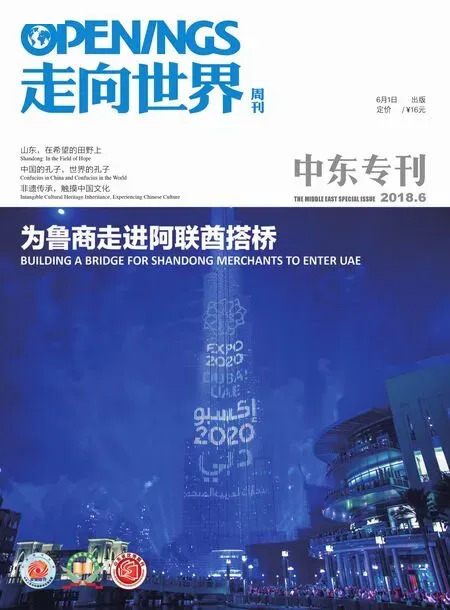非遺傳承,觸摸中國(guó)文化
文/王天宇

○風(fēng)箏節(jié)吸引著世界各地的愛好者前來(lái)。圖/劉富國(guó)The kite festival attracts people from all over the world.
有祭孔大典的莊重威嚴(yán),也有蹴鞠技藝的歡脫喜悅;有木版年畫的藝術(shù)韻味,也有濰坊風(fēng)箏的匠心獨(dú)具;有梁祝傳說(shuō)的凄美婉轉(zhuǎn),也有膠州秧歌的普天同慶;有聊城雜技的翻轉(zhuǎn)騰挪,也有山東快書的嬉笑怒罵……在這片歷史悠久的齊魯大地上,從來(lái)不缺乏人民的藝術(shù),藝術(shù)的人民。
幾張紙,一把剪刀,伴著“咔嚓咔嚓”的剪紙聲,生動(dòng)活潑的形象躍然紙上。山東各地都有剪紙的風(fēng)俗,以高密剪紙為例,其包括窗花、門箋、墻花、頂棚花、燈花、花樣、喜花、春花、喪花等。它的流傳同高密農(nóng)村的節(jié)令風(fēng)俗有著密切的關(guān)系。窗花、門箋、燈花,便是在春節(jié)或元宵節(jié)時(shí)貼掛的。
高密剪紙題材廣泛內(nèi)容豐富,花草蟲魚、飛禽走獸和人物皆可入剪。所剪事物,大多取材于民間傳說(shuō)、神話故事和戲曲故事,象征性強(qiáng),造型樸實(shí)夸張,粗獷中見清秀,拙樸中藏精巧,反映出獨(dú)到的民族審美觀。
小小熒幕撐起大大一片天,觀眾靜候在熒幕前,燈光閃耀在后面,唱念做打喜怒哀樂(lè),皮影似神仙身輕如燕,熒幕前皮影忽隱又忽現(xiàn),飄逸在云和霧里面,傲氣貫山巔,動(dòng)靜掌控全在繞指間。透明的眼,純凈的笑臉,只看顏色就能辨忠奸,皮影終變世代傳承的經(jīng)典。
皮影戲因其獨(dú)特的表演形式成名于世界舞臺(tái),具有濃郁的中國(guó)風(fēng)格。定陶皮影又名隔紙說(shuō)書,是一種山東定陶縣的傳統(tǒng)戲劇藝術(shù)形式,是皮影藝術(shù)的一個(gè)重要地方分支,起源于十九世紀(jì)。相對(duì)于山東其他地方皮影的近乎說(shuō)唱藝術(shù)而言,定陶皮影則近乎地方戲曲,在山東皮影藝術(shù)中可謂獨(dú)樹一幟。馮氏先人于明朝遷居定陶,約在1821年,馮玉旗、馮玉福受剪紙藝術(shù)的啟發(fā)始創(chuàng)了皮影,至今已傳6代。
定陶皮影系用牛皮制作,高一尺有余,風(fēng)格質(zhì)樸粗獷,色澤古拙,刻工勁健,很接近魯西南的剪紙風(fēng)味,具有強(qiáng)烈的地方特色。所取牛皮待洗干刮凈,晾至凈亮透明時(shí)才用于制作。制作時(shí)先將樣稿輕畫于牛皮之上,然后用刀具或刻或鑿,最后上色、熨平,每個(gè)過(guò)程都有專人負(fù)責(zé),最后一關(guān)只有族人才能完成,從不外傳。
濰坊風(fēng)箏是山東濰坊傳統(tǒng)手工藝珍品,民間傳統(tǒng)節(jié)日文化習(xí)俗。是非物質(zhì)文化遺產(chǎn)之一,現(xiàn)在世界上70%以上的風(fēng)箏都是源自濰坊。早在20世紀(jì)30年代,濰坊就曾舉辦過(guò)風(fēng)箏會(huì)。1978年以來(lái),濰坊風(fēng)箏又煥發(fā)了生機(jī),多次應(yīng)邀參加國(guó)內(nèi)外風(fēng)箏展覽和放飛表演。1984年4月1日,首屆濰坊國(guó)際風(fēng)箏會(huì)拉開帷幕。1988年4月1日,第五屆濰坊國(guó)際風(fēng)箏會(huì)召開主席團(tuán)會(huì)議。會(huì)上與會(huì)代表一致通過(guò),確定濰坊市為“世界風(fēng)箏都”。1989年第六屆濰坊國(guó)際風(fēng)箏會(huì)期間,成立了由美國(guó)、日本、英國(guó)、意大利等16個(gè)國(guó)家和地區(qū)風(fēng)箏組織參加的“國(guó)際風(fēng)箏聯(lián)合會(huì)”,并決定把總部設(shè)在濰坊。現(xiàn)在濰坊成為世界風(fēng)箏文化交流的中心,被世界各國(guó)人民稱為風(fēng)箏的故鄉(xiāng)。濰坊風(fēng)箏同中國(guó)許多民間藝術(shù)形式一樣,產(chǎn)生于人們的娛樂(lè)活動(dòng),是寄托著人們的理想和愿望,與人們的生活有密切聯(lián)系的娛樂(lè)品。
除了上述非物質(zhì)文化遺產(chǎn),目前,在山東的非遺名錄中,包含民間文學(xué)、民間音樂(lè)、民間舞蹈、傳統(tǒng)戲劇、曲藝、雜技與競(jìng)技、民間藝術(shù)、傳統(tǒng)手工技藝、傳統(tǒng)醫(yī)藥、民俗等10個(gè)大類。子丑寅卯,歲月更替,從首批國(guó)家級(jí)非物質(zhì)文化遺產(chǎn)到如今,山東已經(jīng)走過(guò)了12年,隨著中國(guó)非遺保護(hù)實(shí)踐在制度建設(shè)、宣傳展示和人才培養(yǎng)三大方面的不斷進(jìn)步,非遺保護(hù)也越來(lái)越受社會(huì)重視。
編輯/王雪芃
There is not only the solemnity and stateliness of the Memorial Ceremony for Confucius, but also the joy and pleasure of Cuju;there is not only the artistic charm of New Year woodprints, but also the originality of Weifang kites; there is not only the sadness and beauty of the legend of the Butterf l y Lovers, but also the common celebration of Jiaozhou Yangko; there is not only the twists and turns of Liaocheng acrobatics, but also the ironic humor of Shandong clapper ballad… The time-honored Land of Qilu never lacks the art of people and the people of art.
Several sheets of paper and a pair of scissors can produce vivid and lively images with the sound of paper-cutting. There is a custom of paper-cutting all over Shandong. Take Gaomi paper-cutting as an example.This includes paper-cuts for window decoration, paper-cuts for hanging on doors, paper-cuts for wall decoration,ceiling paper-cut, lantern paper-cut,paper-cut patterns, wedding papercut, Spring Festival paper-cut, funeral paper-cut, and so forth. Its spread is closely related to the festivals and customs of rural areas in Gaomi. The paper-cut for window decoration, the paper-cut for hanging on doors and the lantern paper-cut were usually pasted on the Spring Festival or Lantern Festival.
Gaomi paper-cut has a wide range of themes and rich contents. Flowers,grass, insects, fi sh, birds, beasts, as well as fi gures can all be paper-cut themes.Most paper-cut themes are derived from folk legends, myths and drama stories, with high symbolization, simple yet exaggerated shapes, exquisiteness in roughness, as well as ingenuity in simplicity, and ref l ect a unique national aesthetic taste.

○皮影是中國(guó)特有的文化。圖/張仁玉Shadow play is the unique culture of China.

○剪紙寄托著中國(guó)人對(duì)美好生活的希望。圖/劉富國(guó)Paper-cut expresses Chinese people's hope to the better life.
A small screen holds up a big sky.The viewers silently wait before the screen, lights shining behind them. By singing, speaking, acting and martial arts, with pleasure, anger, sorrow and joy, shadow puppets move as lightly as swallows. Their shadows fl icker on the screen, and float in clouds and mist,with an incomparable momentum.Movement and quietude are controlled by hand. They have transparent eyes and pure smiling faces. You can distinguish loyal figures from disloyal ones by observing colors. Finally, the shadow puppetry becomes classic passed down from generation to generation.
Due to its unique performance form with a strong Chinese style,shadow puppetry has become famous on the world stage. The Dingtao shadow puppetry, also known as storytelling on paper, is a traditional form of drama art in Dingtao County,Shandong. It is an important regional branch of shadow arts, originated in the 19th century. Compared to the shadow puppetry of other places in Shandong, which is similar to talkingsinging arts, the Dingtao shadow puppetry is similar to a local opera,and forms a unique style in the shadow arts of Shandong. The ancestors of the Feng family moved to Dingtao in the Ming Dynasty. In about 1821, inspired by paper-cut arts, Feng Yuqi and Feng Yufu initiated shadow puppetry,which has been passed down for 6 generations so far.
The shadow puppet of Dingtao is made of cowhide, with a height of above 1/3 meter. Characterized by simple and rough style, unadorned colors and forceful carving, it is similar to the paper-cut of Southwestern Shandong,and has strong local features. After being washed and shaved, the cowhide will be air-dried and will not be used for manufacturing until it becomes bright and transparent. In the manufacturing process, the sample pattern is drawn on the cowhide. Then,a cutter is used for carving or chiseling.At last, it will be dyed and ironed. Each process has a person to take charge.The last step can only be completed by the clansmen, and will never be passed down to others.
Weifang kite is not only a traditional handicraft treasure of Weifang, Shandong, but also a traditional festival cultural custom in folk society. It is one of China’s intangible cultural heritage items. Now,more than 70% of kites worldwide come from Weifang. In the 1930s, Weifang used to hold a kite festival. Since 1978,Weifang kites have been revitalized,and have been invited to domestic and foreign kite exhibitions and kite fl ying performances more than once. On April 1, 1984, the First Weifang International Kite Festival kicked off. On April 1,1988, Weifang City was recognized as the “Kite Capital of the World”. During the Sixth Weifang International Kite Festival in 1989, the “International Kite Federation” was founded with the participation of 16 countries and regions such as the US, Japan, the UK and Italy, and headquartered in Weifang. As with many folk art forms of China, Weifang kites originated from people’s recreational activities. It is an entertainment product that represents our ideals and aspirations, and closely relates to our lives.
In addition to the above intangible cultural heritages, the existing intangible cultural heritage list of Shandong includes 10 categories such as folk literature, folk music, folk dance,traditional drama, Quyi (Chinese folk art forms), acrobatics, athletics, folk art, traditional handicrafts, traditional Chinese medicine and folk customs. As years passed by, from the First Batch of National Intangible Cultural Heritage to now, Shandong has gone through 12 years. With the continuous progress of China’s practice in intangible cultural heritage protection in the aspects of institutional construction, publicity &demonstration and talent cultivation,intangible cultural heritage protection has received more and more social attention.

